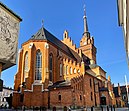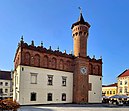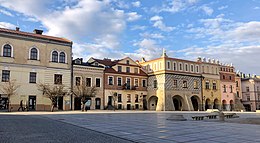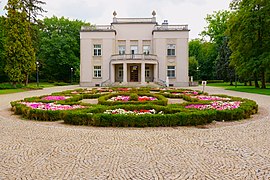Tarnów
Tarnów | ||
|---|---|---|
| ||
|
Car plates KT | | |
| Website | http://www.tarnow.pl | |
| Year | Pop. | ±% |
|---|---|---|
| 1950 | 37,405 | — |
| 1960 | 70,835 | +89.4% |
| 1970 | 85,929 | +21.3% |
| 1980 | 105,109 | +22.3% |
| 1990 | 121,216 | +15.3% |
| 2000 | 120,822 | −0.3% |
| 2010 | 114,635 | −5.1% |
| 2020 | 107,498 | −6.2% |
| source [2] | ||
Tarnów (Polish pronunciation: [ˈtarnuf] ⓘ) is a city in southeastern Poland with 105,922 inhabitants[1] and a metropolitan area population of 269,000 inhabitants. The city is situated in the Lesser Poland Voivodeship since 1999. From 1975 to 1998, it was the capital of the Tarnów Voivodeship. It is a major rail junction, located on the strategic east–west connection from Lviv to Kraków, and two additional lines, one of which links the city with the Slovak border.
Tarnów is known for its traditional
Companies headquartered in the city include Poland's largest chemical industry company Grupa Azoty and defence industry company ZMT. The city is currently subdivided into 16 districts and is a member of the Association of Polish Cities (Związek Miast Polskich).[5]
Names and etymology
The first documented mention of the settlement dates back to 1105, spelled as Tharnow. The name later evolved to Tarnowo (1229), Tarnów (1327), and Tharnow (1473).
History
Already in the mid-9th century, on the Tarnów's St. Martin Mount (Góra sw. Marcina, 2.5 kilometers from the centre of today's city), a
The first documented mention of Tarnów occurs in the year 1309, when a list of miracles of
Tarnów remained in the hands of the Leliwa family, out of which in the 15th century the
Polish–Lithuanian Commonwealth
Habsburg Empire

After the
Tarnów went through the period of quick development in the second half of the 19th century, due to the program of construction of the railway system. In 1852, the town received rail connection with
Second Polish Republic

Tarnów was one of the first Polish cities to be freed during the rebirth of Poland following World War I. The Polish Legions liberated the city on the night of 30–31 October 1918. In the
World War II

During the German invasion of Poland, the city was overrun by the German forces on 7 September 1939. Under German occupation, Tarnów was incorporated into the General Government territory as the seat of the Kreishauptmanschaft Tarnow administrative unit in the Kraków District on 26 October 1939.
In September 1939, the
Post-war period

A few months later, the Museum of Tarnów Land was opened, and Tarnów began a postwar recovery. In 1957, State Theatre of Ludwik Solski was opened, and in 1975 Tarnów became the capital of a voivodeship.
The Jews of Tarnów
Before World War II, about 25,000 Jews lived in Tarnów.[16] Jews, whose recorded presence in the town went back to the mid-15th century, comprised about half of the town's total population. A large portion of Jewish business in Tarnów was devoted to garment and hat manufacturing. The Jewish community was ideologically diverse and included religious Hasidim, secular Zionists, and many more.[17]

Immediately following the German occupation of the city on 8 September 1939, the persecution of the Jews began. German units burned down most of the city's synagogues on 9 September and drafted Jews for forced-labor projects.[16] Tarnów was incorporated into the Generalgouvernement. Many Tarnów Jews fled to the east, while a large influx of refugees from elsewhere in occupied Poland continued to increase the town's Jewish population. In early November, the Germans ordered the establishment of a Jewish council (Judenrat) to transmit orders and regulations to the Jewish community. Among the duties of the Jewish council were enforcement of special taxation on the community and providing workers for forced labor.[17]
During 1941, life for the Jews of Tarnów became increasingly precarious.[16] The Germans imposed a large collective fine on the community. Jews were required to hand in their valuables. Roundups for labor became more frequent and killings became more commonplace and arbitrary. Deportations from Tarnów began in June 1942, when about 13,500 Jews were sent to the Belzec extermination camp. The first major act in the extermination of the Jews of Tarnów was the so-called "first operation" from 11–19 June 1942. The Germans gathered thousands of Jews in the Rynek (market place), and then they were tortured and killed. During this time period, on the streets of the town and in the Jewish cemetery, about 3,000 Jews were shot; in the woods of Zbylitowska Góra a few kilometers away from Tarnów a further 7,000 were murdered.[18] According to a document from Michal Borawski born in 1926, featured at the entry of the Bimah as part of the panel offered by the Batory Foundation, the street stairs ("małe schody" or little stairs) from the town-center to the Bernardynski street (where the Bernardine Monastery is located), had to be cleaned of the blood by the local fire brigade for three days.[19] Poles gave shelter to several Jewish escapees from the ghetto, however, several Poles were eventually captured and murdered by the Germans for rescuing Jews.[20][21] Many Poles were imprisoned by the Germans in the local prison for rescuing and helping Jews and then often deported to Auschwitz and other concentration camps, in which some died, while some fortunately survived until the end of the war.[22]
After the June deportations, the Germans forced the surviving Jews of Tarnów, along with thousands of Jews from neighboring towns, into the new Tarnów Ghetto. The ghetto was surrounded by a high wooden fence. Living conditions in the ghetto were deplorable, marked by severe food shortages, a lack of sanitary facilities, and a forced-labor regimen in factories and workshops producing goods for the German war industry. In September 1942, the Germans ordered all ghetto residents to report to Targowica Square, where they were subjected to a 'selection' in which those deemed 'non-essential' were singled out for deportation to Belzec. About 8,000 people were deported. Thereafter, deportations from Tarnów to extermination camps continued sporadically; the Germans deported a group of 2,500 in November 1942.[16]
Holocaust resistance
In the midst of the 1942 deportations, some Jews in Tarnów organized a
Property restoration
Our Lady of the Scapular
The church of Our Lady of the Scapular in Tarnów was built on a plot that was illegally obtained by the parish from the descendants of Jewish Holocaust survivors. The plot, which belonged to a Goldman family, remained in the care of family friend Jerzy Poetschkes after Blanka Drillich (née Goldman), the last remnant of the family, left Poland after the war. In 1987 Poetchkes, with the advice of parish lawyers, claimed that the plot has been abandoned (i.e. the last owner is unknown, or had perished), despite being in contact with the Drillichs; he then sold half the plot and transferred the other half to the Church. In 2016, following a lengthy legal battle, a three judge panel found the Church had acted in bad faith and had no legal rights to the property. A year later the case was re-opened after the Church appealed to the local district attorney, with the personal involvement of Minister of Justice Zbigniew Ziobro.[23][24]
Geography
Tarnów lies at the
Climate
Its climate is classified as marine west coast (Cfb) by Köppen. Tarnów is one of the warmest cities in Poland. The average temperature in January is −0.4 °C (31 °F) and 19.8 °C (68 °F) in July.[26] It is claimed that Tarnów has the longest summer in Poland spreading from mid May to mid September (above 118 days).
| Climate data for Tarnów (1991–2020 normals, extremes 1951–present) | |||||||||||||
|---|---|---|---|---|---|---|---|---|---|---|---|---|---|
| Month | Jan | Feb | Mar | Apr | May | Jun | Jul | Aug | Sep | Oct | Nov | Dec | Year |
| Record high °C (°F) | 15.5 (59.9) |
20.6 (69.1) |
24.8 (76.6) |
31.1 (88.0) |
33.4 (92.1) |
35.5 (95.9) |
37.7 (99.9) |
37.9 (100.2) |
36.8 (98.2) |
27.6 (81.7) |
22.1 (71.8) |
19.5 (67.1) |
37.9 (100.2) |
| Mean daily maximum °C (°F) | 2.1 (35.8) |
4.0 (39.2) |
8.8 (47.8) |
15.5 (59.9) |
20.4 (68.7) |
23.7 (74.7) |
25.6 (78.1) |
25.5 (77.9) |
19.9 (67.8) |
14.4 (57.9) |
8.3 (46.9) |
3.2 (37.8) |
14.3 (57.7) |
| Daily mean °C (°F) | −1.1 (30.0) |
0.2 (32.4) |
3.9 (39.0) |
9.7 (49.5) |
14.4 (57.9) |
17.9 (64.2) |
19.6 (67.3) |
19.1 (66.4) |
14.1 (57.4) |
9.4 (48.9) |
4.7 (40.5) |
0.3 (32.5) |
9.4 (48.9) |
| Mean daily minimum °C (°F) | −4.0 (24.8) |
−3.0 (26.6) |
−0.1 (31.8) |
4.3 (39.7) |
8.7 (47.7) |
12.2 (54.0) |
13.9 (57.0) |
13.4 (56.1) |
9.3 (48.7) |
5.4 (41.7) |
1.8 (35.2) |
−2.5 (27.5) |
5.0 (41.0) |
| Record low °C (°F) | −30.3 (−22.5) |
−28.2 (−18.8) |
−24.6 (−12.3) |
−7.5 (18.5) |
−3.2 (26.2) |
0.2 (32.4) |
5.5 (41.9) |
2.9 (37.2) |
−3.0 (26.6) |
−7.8 (18.0) |
−15.8 (3.6) |
−27.6 (−17.7) |
−30.3 (−22.5) |
| Average precipitation mm (inches) | 34.7 (1.37) |
33.7 (1.33) |
38.5 (1.52) |
53.2 (2.09) |
92.1 (3.63) |
92.8 (3.65) |
107.2 (4.22) |
66.4 (2.61) |
71.8 (2.83) |
51.5 (2.03) |
38.0 (1.50) |
33.2 (1.31) |
713.2 (28.08) |
| Average extreme snow depth cm (inches) | 9.2 (3.6) |
11.2 (4.4) |
6.1 (2.4) |
2.3 (0.9) |
0.0 (0.0) |
0.0 (0.0) |
0.0 (0.0) |
0.0 (0.0) |
0.0 (0.0) |
0.5 (0.2) |
4.3 (1.7) |
5.7 (2.2) |
11.2 (4.4) |
| Average precipitation days (≥ 0.1 mm) | 17.07 | 14.66 | 14.77 | 13.37 | 15.03 | 14.57 | 14.97 | 11.87 | 12.47 | 13.17 | 13.21 | 15.08 | 170.22 |
| Average snowy days (≥ 0 cm) | 18.6 | 16.7 | 7.3 | 1.1 | 0.0 | 0.0 | 0.0 | 0.0 | 0.0 | 0.4 | 5.3 | 12.7 | 62.1 |
| Average relative humidity (%)
|
82.2 | 79.1 | 73.6 | 68.2 | 70.7 | 72.1 | 73.2 | 73.9 | 78.9 | 80.9 | 82.9 | 83.2 | 76.6 |
| Mean monthly sunshine hours | 51.3 | 69.9 | 120.1 | 176.2 | 222.0 | 230.0 | 240.3 | 235.6 | 155.0 | 115.9 | 60.9 | 45.6 | 1,722.7 |
| Source 1: Institute of Meteorology and Water Management[27][28][29][30][31][32][33][34] | |||||||||||||
| Source 2: Meteomodel.pl (records, relative humidity 1991–2020)[35][36][37] | |||||||||||||
Economy

Tarnów is an important center of
Another significant company based in Tarnów is the
Among the major shopping malls in Tarnów are the Gemini Park Tarnów and Galeria Tarnovia.
Transport

Tarnów is an important road and rail hub. It lies at the intersection of two major roads – the ![]() motorway along European route E40, and the National Road No. 73, which goes from Kielce to Jasło. Furthermore, the city is a rail junction, with four lines: three main electrified routes (westward to Kraków, eastward to Dębica and southward to Nowy Sącz), as well as secondary-importance local connection to Szczucin. The history of rail transport in Tarnów dates back to the year 1856, when the Galician Railway of Archduke Charles Louis reached the city. The architectural complex of Tarnów Main Station, fashioned after the Lviv railway station was completed in 1906 in the Austrian Partition of Poland. Since 2010, Tarnów station houses a gallery of modern art, the only such gallery located in a rail station in Poland. Tarnów also has three additional stations: Tarnów Mościce, as well as Tarnów Północny and Tarnów Klikowa, both of which are currently out of service.
motorway along European route E40, and the National Road No. 73, which goes from Kielce to Jasło. Furthermore, the city is a rail junction, with four lines: three main electrified routes (westward to Kraków, eastward to Dębica and southward to Nowy Sącz), as well as secondary-importance local connection to Szczucin. The history of rail transport in Tarnów dates back to the year 1856, when the Galician Railway of Archduke Charles Louis reached the city. The architectural complex of Tarnów Main Station, fashioned after the Lviv railway station was completed in 1906 in the Austrian Partition of Poland. Since 2010, Tarnów station houses a gallery of modern art, the only such gallery located in a rail station in Poland. Tarnów also has three additional stations: Tarnów Mościce, as well as Tarnów Północny and Tarnów Klikowa, both of which are currently out of service.
The city's public transport system consists of 29 municipal bus routes, which provide convenient transportation to all districts. In 1911–1942 Tarnów had a tram line, with the length of 2.5 kilometres, since replaced by buses.[6]
Politics
Members of Parliament (
Tourism
Tarnów is an important tourist, cultural and economic center in Lesser Poland Voivodeship. The old town of Tarnów, called the "pearl of the Polish Renaissance", is one of the most beautiful examples of the Renaissance architectural layout of Polish cities.
Tourist Information
Detailed information about the city, tourist attractions, cultural events and other things are provided by Tourist Information Center, located in the southern part of Main Square. Office is well equipped with a wide variety of brochures and souvenirs, it also serves as a bike rental spot, luggage storage and small guesthouse (4 rooms/8 beds).
Tourist Information Center
- Rynek 7, 33–100 Tarnów V-IX.[38]
Attractions
Points of interest around the city include:
|
|
-
Market Square with historic and colourfultenements
-
Town Hall
-
Cathedral of the Nativity
-
Mikolajowski House
-
16th century fortified tower
-
Existing remains of the old synagogue
-
Gothic RevivalChurch of the Holy Family
-
Railway station in Tarnów
-
Eugeniusz Kwiatkowski villa in Mościce
-
Modernist housing estates in Mościce
Education

- University of Applied Sciences in Tarnów, UAS (Akademia Nauk Stosowanych w Tarnowie, ANS)
- Lesser Poland Higher School of Economics (Małopolska Wyższa Szkoła Ekonomiczna)
- Higher School of Business (Wyższa Szkoła biznesu)
- Higher Theological Seminary in Tarnów (Wyższe Seminarium Duchowne w Tarnowie, WSD)
- John Paul II High School in Tarnów (IV Liceum Ogólnokształcące im. Jana Pawła II w Tarnowie)
Sports

The list features selected sport teams based in Tarnów:
- Unia Tarnów – speedway team, Polish Champions in 2004, 2005 and 2012. They race at the Jaskółcze Gniazdo Municipal Stadium and are sponsored by MościceNitrate Factory and is also popularly known as Jaskółki (Swallows).
- ZKS Unia Tarnów – Zakładowy Klub Sportowy Unia Tarnów (Workplace Sports Club United Tarnów) – association football team, which plays in the lower leagues.
- Tarnovia Tarnów – association football team, which plays in the lower leagues, but played in Poland's top division in the past, most recently in 1948.
- Unia Wisła Paged Tarnów – men's basketball team, which plays in the lower leagues, but played in Poland's top divisionin the past, most recently in 2007.
- Grupa Azoty Unia Tarnów – men's handball team playing in the Polish Superliga.
- Roleski Grupa Azoty PWSZ Tarnów – women's volleyball team playing in the TAURON Liga, the highest level of women's volleyball played in Poland.
Religion
Besides Catholics, other Christian denominations are also present in Tarnów including Baptist Church, Free Brothers Church, Jehovah's Witnesses, Methodist Church, Pentecostal Church, Seventh-day Adventist Church and the non-denominational Evangelical Movement "The Lord is my Banner". Before World War II there was a large population of Jews comprising half of the city's population, but now there remain just monuments of their past presence.
According to 2007 Catholic Church statistics provided by the Instytut Statystyki Kościoła Katolickiego SAC, Tarnów is the most religious city in Poland, with 72.5% of the congregation of the Diocese of Tarnów attending Mass.
International relations
Twin towns – Sister cities
Tarnów is
Former twin towns:
In June 2021, the Tarnów city council decided to suspend its partnership with the Ukrainian town of Ternopil as a reaction to the naming of a stadium in Ternopil in honour of Roman Shukhevych, one of the leaders of the Ukrainian Insurgent Army responsible for massacres of Poles in Volhynia and Eastern Galicia perpetrated between 1943–1945.[42]
Notable people





- Stella Bloch (1897–1999), American artist, dancer and journalist
- Roman Brandstaetter (1906–1987), writer
- Poland
- Charles Denner (1926–1995), French actor
- Jan Drohojowski (1901–1979), diplomat
- Jacek Dukaj (born 1974), writer
- Stefan Filipkiewicz (1879–1944), painter
- Ignace J(ay). Gelb (1907–1985), Polish-American ancient historian, Assyriologist
- Allan Gray (born Josef Żmigród, 1902–1973), composer
- Michał Heller (born 1936), philosopher
- Marcin Hycnar (born 1983), actor
- Rabbi Löb Judah ben Isaac[44]
- Natalia Kałucka (born 2001), competition climber
- Bartosz Kapustka (born 1996), footballer
- Israel Mendel Keller[45]
- Leon Kellner (1859–?), Jewish scholar[45]
- Mateusz Klich (born 1990), footballer
- Tadeusz Klimecki (1895–1943), Chief of Polish General Staff
- Renata Knapik-Miazga (born 1988), épée fencer
- José Krakover (1883–1957), Argentinian Jewish photographer
- Andrzej Krasicki (1918–1995), film and theatre actor and theatre director
- Krystyna Kuperberg (born 1944), mathematician
- Franciszek Latinik (1864–1949), military officer
- Siegfried Lipiner (1856–1911), Galician-Austrian Jewish poet[46]
- Andrew Odlyzko (born 1949), mathematician
- Anny Ondra (1903–1987), Czech film actress
- Stanisław Opałko (1911–1993), industrialist and politician
- Joseph Öttinger (1818–1895), Galician-Jewish physician[47]
- Ksawery Masiuk (born 2004), swimmer
- Lidia Morawska (born 1952), physicist[48]
- Agata Mróz-Olszewska (1982–2008), volleyball player and two-time European Champion
- Luke Nosek (born 1975), Polish-American entrepreneur, co-founder of PayPal
- Tony Rickardsson (born 1970), motorcycle speedway rider, honorable resident since 2006
- Ignacy Schiper (1884–1943), Jewish historian and politician
- Eustachy Stanisław Sanguszko (1842–1903), nobleman, conservative politician
- Wilhelm Sasnal (born 1972), painter
- Jan Szczepanik (1872–1926), inventor
- Jan Tarnowski (1488–1561), nobleman and Hetman.[49]
- Jan of Tarnów (c. 1349–1409), nobleman
- Jan of Tarnów (1367–1433), nobleman
- Rafał z Tarnowa(c. 1330–1373), nobleman
- Zofia Vetulani (1893–1981), civil servant, social and political activist
- Rabbi Marcus Weissmann-Chajes (1830–1914), Jewish scholar[50]
- Rabbi Salo Wittmayer Baron (1895–1989), Jewish historian
- Jan Wojnarski (1879–1937), painter and graphic artist
- Marcin Wrona (1973–2015), film director
- Franciszek Zachara (1898–1966), composer and pianist
- Maciej Zembaty (1944–2011), artist and comedian
See also
References
- ^ a b "Local Data Bank". Statistics Poland. Retrieved 7 August 2022. Data for territorial unit 1263000.
- ^ "Tarnów (Małopolskie) » mapy, nieruchomości, GUS, noclegi, szkoły, regon, atrakcje, kody pocztowe, wypadki drogowe, bezrobocie, wynagrodzenie, zarobki, tabele, edukacja, demografia".
- ^ Gzyl, Krzysztof. "Tarnów / Worth seeing / Tarnow and region – Tourist Information – Polski Biegun Ciepła * Polish Hot-Spot". www.it.tarnow.pl. Retrieved 9 November 2017.
- ^ Gzyl, Krzysztof. "Tarnów – the warmest place in Poland / Did you know that...? / Worth seeing / Tarnow and region – Tourist Information – Polski Biegun Ciepła * Polish Hot-Spot". www.it.tarnow.pl. Retrieved 9 November 2017.
- ^ "Miasta członkowskie" (in Polish). Retrieved 25 September 2022.
- ^ a b c d e Gmina Miasta Tarnowa. "Kalendarium miasta Tarnowa". Retrieved 1 April 2016.
- ^ "Tarnów - Castle". medievalheritage.eu. Retrieved 26 May 2023.
- ^ Zdzisław Spieralski, Jan Tarnowski 1488–1561, Warszawa 1977, pp. 124–125.
- ^ (in English) "Volume 24". The Penny cyclopædia of the Society for the Diffusion of Useful Knowledge. C. Knight. 1842. p. 66.
- ^ Krzysztof Gzyl (2018). "Bombing attack at the train station in Tarnów" [Zamach bombowy na tarnowskim dworcu kolejowym]. Taka jest historia (in Polish). Tarnów i region at it.tarnow.pl.
- ^ Wardzyńska, Maria (2009). Był rok 1939. Operacja niemieckiej policji bezpieczeństwa w Polsce. Intelligenzaktion (in Polish). Warszawa: IPN. pp. 58–59.
- ISBN 978-83-8098-174-4.
- ^ Wardzyńska (2009), p. 261
- Biblioteka Jagiellońska. p. 81.
- ^ a b "Transporty z obozu Dulag 121". Muzeum Dulag 121 (in Polish). Retrieved 1 April 2021.
- ^ a b c d e "Tarnow". Ushmm.org. OTRS Ticket. Retrieved 24 April 2013.
- ^ Museum of the History of Polish Jews in Warsaw.
- ^ Adam Bartosz, In the footsteps of the Jews of Tarnów, 2007 Archived 2 March 2012 at the Wayback Machine
- ^ "Batory Foundation English homepage". Batory.org.pl. Retrieved 26 September 2013.
- ^ Rejestr faktów represji na obywatelach polskich za pomoc ludności żydowskiej w okresie II wojny światowej (in Polish). Warszawa: IPN. 2014. pp. 344, 414, 419.
- ^ Datner, Szymon (1968). Las sprawiedliwych (in Polish). Warszawa: Książka i Wiedza. p. 50.
- ^ Rejestr faktów represji na obywatelach polskich za pomoc ludności żydowskiej w okresie II wojny światowej, pp. 212, 220, 238, 245, 251, 256, 274, 280, 308
- ISSN 0261-3077. Retrieved 4 October 2019.
- ^ Aderet, Ofer (8 September 2019). "A Church Was Built on Holocaust Survivor's Land in Poland. Her Daughter Wants It Back". Haaretz. Retrieved 4 October 2019.
- ISBN 83-903260-1-9.)
{{cite book}}: CS1 maint: location missing publisher (link - ^ "TARNW, Weather History and Climate Data". Worldclimate.com. 4 February 2007. Retrieved 6 May 2009.
- ^ "Średnia dobowa temperatura powietrza". Normy klimatyczne 1991-2020 (in Polish). Institute of Meteorology and Water Management. Archived from the original on 3 December 2021. Retrieved 22 January 2022.
- ^ "Średnia minimalna temperatura powietrza". Normy klimatyczne 1991-2020 (in Polish). Institute of Meteorology and Water Management. Archived from the original on 15 January 2022. Retrieved 22 January 2022.
- ^ "Średnia maksymalna temperatura powietrza". Normy klimatyczne 1991-2020 (in Polish). Institute of Meteorology and Water Management. Archived from the original on 15 January 2022. Retrieved 22 January 2022.
- ^ "Miesięczna suma opadu". Normy klimatyczne 1991-2020 (in Polish). Institute of Meteorology and Water Management. Archived from the original on 9 January 2022. Retrieved 22 January 2022.
- ^ "Liczba dni z opadem >= 0,1 mm". Normy klimatyczne 1991-2020 (in Polish). Institute of Meteorology and Water Management. Archived from the original on 15 January 2022. Retrieved 22 January 2022.
- ^ "Średnia grubość pokrywy śnieżnej". Normy klimatyczne 1991-2020 (in Polish). Institute of Meteorology and Water Management. Archived from the original on 15 January 2022. Retrieved 22 January 2022.
- ^ "Liczba dni z pokrywą śnieżna > 0 cm". Normy klimatyczne 1991-2020 (in Polish). Institute of Meteorology and Water Management. Archived from the original on 21 January 2022. Retrieved 22 January 2022.
- ^ "Średnia suma usłonecznienia (h)". Normy klimatyczne 1991-2020 (in Polish). Institute of Meteorology and Water Management. Archived from the original on 15 January 2022. Retrieved 22 January 2022.
- ^ "Tarnów Absolutna temperatura maksymalna" (in Polish). Meteomodel.pl. Retrieved 22 January 2022.
- ^ "Tarnów Absolutna temperatura minimalna" (in Polish). Meteomodel.pl. 6 April 2018. Retrieved 22 January 2022.
- ^ "Tarnów Średnia wilgotność" (in Polish). Meteomodel.pl. 6 April 2018. Retrieved 22 January 2022.
- ^ Tourist Information Center
- ^ "Miasta Partnerskie". Retrieved 1 May 2014.
- ^ "Testvértelepülések". Retrieved 30 April 2014.
- ^ "Miasta partnerskie i zaprzyjaźnione Nowego Sącza". Urząd Miasta Nowego Sącza (in Polish). Archived from the original on 23 May 2013. Retrieved 1 August 2013.
- ^ "Tarnów zawiesza współpracę z Tarnopolem" (in Polish). Retrieved 14 September 2021.
- ^ Bain, Robert Nisbet (1911). . Encyclopædia Britannica. Vol. 3 (11th ed.). p. 713.
- ^ "Löb Judah B. Isaac". JewishEncyclopedia.com. Retrieved 24 April 2013.
- ^ a b "Kellner, Leon". JewishEncyclopedia.com. Retrieved 24 April 2013.
- ^ "Lipiner, Siegfried". JewishEncyclopedia.com. Retrieved 24 April 2013.
- ^ "Öttinger, Joseph". JewishEncyclopedia.com. Retrieved 24 April 2013.
- ^ "Rozmowa z Lidią Morawską". przemysl.naszemiasto.pl (in Polish). 16 January 2003. Retrieved 17 September 2021.
- ^ Bain, Robert Nisbet (1911). . Encyclopædia Britannica. Vol. 26 (11th ed.). pp. 429–430.
- ^ "Weissmann-Chajes, Marcus". JewishEncyclopedia.com. Retrieved 24 April 2013.
Note
- This article incorporates text from the GFDL as "Tarnow". OTRS ticket number.
External links
![]() Media related to Tarnów at Wikimedia Commons
Media related to Tarnów at Wikimedia Commons
- . Encyclopædia Britannica. Vol. 26 (11th ed.). 1911. p. 429.
- City of Tarnów English version of Tarnów's official webpage
- Tarnów, Poland at JewishGen



















